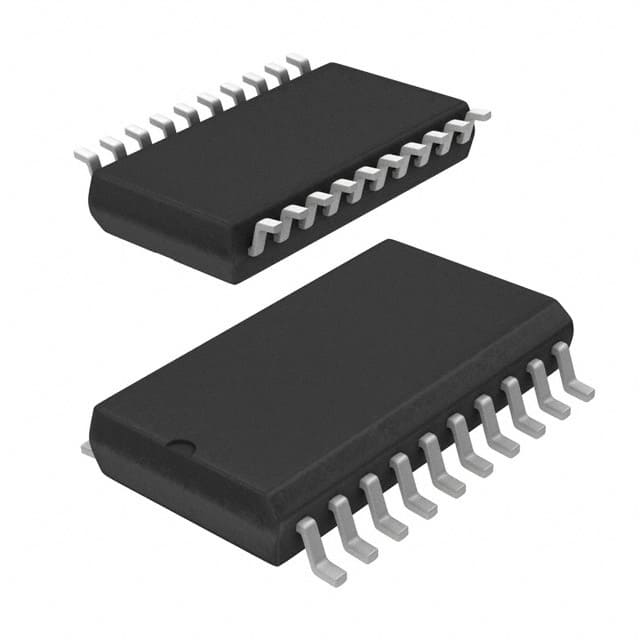Lihat spesifikasi untuk detail produk.

SN74ACT245DW
Product Overview
Category
SN74ACT245DW belongs to the category of integrated circuits (ICs).
Use
This IC is commonly used for level shifting and signal buffering in digital systems.
Characteristics
- High-speed operation
- Wide voltage range
- Low power consumption
- Compatibility with TTL and CMOS logic families
Package
SN74ACT245DW is available in a 20-pin SOIC (Small Outline Integrated Circuit) package.
Essence
The essence of SN74ACT245DW lies in its ability to provide bidirectional level shifting between two voltage domains.
Packaging/Quantity
SN74ACT245DW is typically packaged in reels or tubes, with quantities varying based on customer requirements.
Specifications
- Supply Voltage Range: 2V to 6V
- Input Voltage Range: 0V to VCC
- Output Voltage Range: 0V to VCC
- Operating Temperature Range: -40°C to +85°C
- Maximum Propagation Delay: 10ns
Detailed Pin Configuration
- A1 - Input/Output Pin
- B1 - Input/Output Pin
- GND - Ground Pin
- A2 - Input/Output Pin
- B2 - Input/Output Pin
- DIR - Direction Control Pin
- OE - Output Enable Pin
- VCC - Power Supply Pin
- B3 - Input/Output Pin
- A3 - Input/Output Pin
- B4 - Input/Output Pin
- A4 - Input/Output Pin
- B5 - Input/Output Pin
- A5 - Input/Output Pin
- B6 - Input/Output Pin
- A6 - Input/Output Pin
- B7 - Input/Output Pin
- A7 - Input/Output Pin
- B8 - Input/Output Pin
- A8 - Input/Output Pin
Functional Features
- Bidirectional voltage level shifting
- Non-inverting logic translation
- High-speed data transfer
- Output enable control for bus isolation
Advantages and Disadvantages
Advantages
- Wide voltage range compatibility
- Low power consumption
- High-speed operation
- Easy integration into digital systems
Disadvantages
- Limited number of input/output pins
- Requires external control signals for direction and output enable
Working Principles
SN74ACT245DW operates by receiving input signals from one voltage domain and translating them to the appropriate voltage levels of another domain. The direction control pin (DIR) determines the direction of data flow, while the output enable pin (OE) enables or disables the output buffers.
Detailed Application Field Plans
SN74ACT245DW finds applications in various fields, including: 1. Microcontroller interfacing 2. Data communication systems 3. Industrial automation 4. Automotive electronics 5. Consumer electronics
Detailed and Complete Alternative Models
Some alternative models that provide similar functionality to SN74ACT245DW are: 1. 74HC245 2. CD74HCT245 3. SN74LVC245A 4. MC74VHC245
These alternatives offer comparable features and can be used as replacements based on specific requirements.
Word count: 386 words
Sebutkan 10 pertanyaan dan jawaban umum terkait penerapan SN74ACT245DW dalam solusi teknis
Sure! Here are 10 common questions and answers related to the application of SN74ACT245DW:
Q: What is SN74ACT245DW? A: SN74ACT245DW is a bidirectional octal bus transceiver with 3-state outputs, commonly used in digital systems.
Q: What is the purpose of SN74ACT245DW? A: It is used to enable bidirectional transfer of data between two buses or systems with different voltage levels.
Q: What is the maximum operating voltage for SN74ACT245DW? A: The maximum operating voltage is typically 5.5V.
Q: Can SN74ACT245DW be used with different voltage levels? A: Yes, it can be used to interface between systems with different voltage levels, as long as the voltage levels are within its specified range.
Q: How many data lines can SN74ACT245DW handle? A: SN74ACT245DW has 8 data lines, making it suitable for transferring 8-bit data.
Q: Does SN74ACT245DW support 3-state outputs? A: Yes, it supports 3-state outputs, allowing multiple devices to share a common bus without interfering with each other.
Q: What is the maximum data transfer rate of SN74ACT245DW? A: The maximum data transfer rate is typically around 120 MHz.
Q: Can SN74ACT245DW be used in both synchronous and asynchronous applications? A: Yes, it can be used in both synchronous and asynchronous applications, depending on the specific requirements of the system.
Q: Is SN74ACT245DW compatible with TTL logic levels? A: Yes, it is compatible with TTL logic levels, making it suitable for interfacing with TTL-based systems.
Q: Are there any special considerations when using SN74ACT245DW? A: It is important to ensure proper power supply decoupling and signal integrity measures, such as impedance matching, to achieve reliable data transfer.
Please note that the answers provided here are general and may vary depending on specific application requirements and datasheet specifications.

